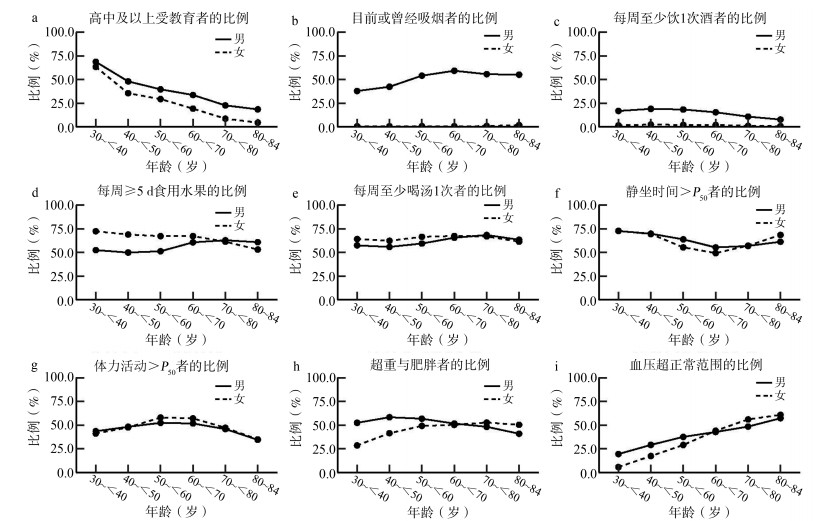Prospective cohort of chronic diseases among urban residents in Guangdong Province: design and baseline characteristics of subjects from 2018 to 2019
-
摘要:
目的 研究广东省城市居民健康相关因素的分布情况,为进一步揭示广东省城市居民慢性非传染性疾病的流行特征及发病规律奠定基础。 方法 2018年3月1日―2019年10月30日在广东省广州市、东莞市及深圳市开展基线调查,包括问卷调查、体格检查、生物样本采集和实验室检测,建立了包含34 764名30~84岁研究对象的基线数据库和生物样本库。 结果 34 764名调查对象的年龄为(53.31±12.61)岁,男性占41.1%。调查对象目前吸烟率男性为34.4%,女性0.4%;有饮酒习惯的男性比例为16.7%,女性为1.9%;BMI≥24 kg/m2的男性占54.4%,女性占44.4%;男性腰围≥90 cm的比例为35.8%,女性腰围≥85 cm的比例为34.0%;调查时男性血压超过正常范围(SBP≥140 mm Hg或DBP≥90 mm Hg)的比例为34.8%,女性的比例为28.8%。 结论 广东省城市居民中饮食、吸烟、饮酒及肥胖等慢性非传染性疾病相关因素在不同性别和年龄人群中存在不同的分布特征。 Abstract:Objective To explore the distribution of health relative factors and further reveal the epidemic characteristics and incidence of chronic diseases among urban residents in Guangdong Province. Methods From March 1, 2018 to October 30, 2019, a baseline survey was conducted in Guangzhou, Dongguan and Shenzhen of Guangdong Province, including questionnaire, physical examination, biological sample collection and laboratory test. A cohort baseline database and a biobank of 34 764 subjects aged 30 to 84 were established. Results 34 764 participants with age of (53.31±12.61) years including 41.1% males, were recruited in this study. The prevalence of current smoking was 34.4% in men and 0.4% in women. The prevalence of current regular alcohol drinking was 16.7% in men and 1.9% in women. The proportion of participants whose BMI ≥24 kg/m2 was 54.4% in men and 44.4% in women. 35.8% of males had a waist circumference greater than 90 cm, while 34.0% of females had a waist cir-cumference greater than 85 cm. The proportion of participants who were hypertensive (SBP ≥140 mm Hg or DBP ≥90 mm Hg) was 34.8% in men and 28.8% in women. Conclusions The factors related to chronic diseases, such as diet, smoking, drinking and obesity, showed different distribution of characteristics among urban residents in Guangdong Province of different genders and ages. -
Key words:
- Cohort study /
- Chronic diseases /
- Baseline
-
表 1 SCC调查问卷主要内容
Table 1. The main contents of SCC questionnaire
调查条目 具体内容 一般社会学信息 性别、出生日期、教育程度、职业、婚姻状况及家庭经济收入 个人及家庭健康状况 高血压、糖尿病、冠心病、脑卒中及恶性肿瘤等11种常见慢性病的患病史及相应药物史; 家庭直系亲属6种常见慢性病患病情况 吸烟情况 最近1年至少半年以上每天吸烟≥1支,或每周吸烟≥7支定义为每天吸烟[6]; 戒烟定义为至少持续半年及以上未吸烟; 对于过去每天吸烟与现在每天吸烟者,进一步了解每天吸烟的量、戒烟的年份及原因等 饮酒情况 饮酒后症状,1年内饮酒频率及过往是否经常饮酒,每周至少1次饮酒且持续时间≥1年则为经常饮酒[7]; 对于如今经常饮酒或过往经常饮酒者,进一步了解每周具体饮酒天数、开始饮酒年龄、饮酒种类和饮酒量 饮茶情况 过去1年的饮茶频率,对于每周至少饮茶1次的常饮茶者进一步了解每周饮茶频率、开始饮茶年龄、具体饮茶种类和饮茶量 膳食情况 早餐与宵夜的食用频次; 14类常见种类食物的食用频率; 饮汤煲汤的习惯; 三大类营养补充剂的使用情况 被动吸烟和室内空气污染 是否与吸烟者有共同生活史以及每周暴露于二手烟的频率和累计接触时间; 室内空气污染主要包括厨房燃料的空气污染情况 体力活动情况 过去1年中工作有关的体力活动情况; 上下班方式及路程所花的时间; 国际体力活动量表(international physical activity questionnaire,IPAQ)短卷评分 女性生育史 女性月经史、怀孕史、生育史、母乳喂养史、避孕药使用史以及妇科手术史 精神/睡眠/情绪/其他情况 大便排便情况; 匹茨堡睡眠质量量表(Pittsburgh sleep quality index,PSQI)[8]以及午睡习惯; 生活满意程度以及原因不明的恐惧症等情况 表 2 2018―2019年广东省城市居民慢性病前瞻性队列基线调查指标的性别分布[n(%)]
Table 2. Baseline characteristics of participants by gender in prospective cohort of chronic diseases among urban residents in Guangdong Province from 2018 to 2019 [n(%)]
指标 合计(N=34 764) 男(n=14 293) 女(n=20 471) 指标 合计(N=34 764) 男(n=14 293) 女(n=20 471) 年龄[岁, (x±s)] 53.31±12.61 53.18±12.76 53.40±12.51 体力活动水平(量表分级) 30~<40 5 740(16.5) 2 454(17.2) 3 286(16.1) 低强度 9 034(26.0) 3 990(27.9) 5 044(24.6) 40~<50 9 207(26.5) 3 837(26.8) 5 370(26.2) 中强度 14 397(41.4) 5 805(40.6) 8 592(42.0) 50~<60 8 071(23.2) 3 180(22.2) 4 891(23.9) 高强度 11 333(32.6) 4 498(31.5) 6 835(33.4) 60~<70 7 531(21.7) 3 041(21.3) 4 490(21.9) 患病情况 70~<80 3 717(10.7) 1 549(10.8) 2 168(10.6) 糖尿病 2 360(6.8) 1 060(7.4) 1 300(6.4) 80~84 498(1.4) 232(1.6) 266(1.3) 冠心病 584(1.7) 292(2.0) 292(1.4) 教育 脑卒中/小卒中 313(0.9) 187(1.3) 126(0.6) 未正规上过学 1 797(5.2) 231(1.6) 1 566(7.6) 高血压 6 873(19.8) 3 001(21.0) 3 872(18.9) 小学 8 813(25.4) 2 721(19.0) 6 092(29.8) 慢性肺部疾病 204(0.6) 136(1.0) 68(0.3) 初中 11 441(32.9) 5 126(35.9) 6 315(30.8) 恶性肿瘤 240(0.7) 61(0.4) 179(0.9) 高中(包括中专/技校) 7 199(20.7) 3 571(25.0) 3 628(17.7) BMI [kg/m2, (x±s)] 24.09±3.46 24.41±3.32 23.86±3.53 大专及以上 5 514(15.9) 2 644(18.5) 2 870(14.0) < 18.5 1 167(3.4) 418(2.9) 749(3.7) 婚姻 18.5~<24.0 16 756(48.2) 6 133(42.9) 10 623(51.9) 已婚 31 823(91.5) 13 573(95.0) 18 250(89.2) 24.0~<28.0 12 552(36.1) 5 878(41.4) 6 674(32.6) 丧偶 1 713(4.9) 238(1.7) 1 475(7.2) ≥28.0 4 289(12.3) 1 864(13.0) 2 425(11.8) 分居/离婚 568(1.6) 178(1.2) 390(1.9) 腰围[cm, (x±s)] a 83.35±9.69 86.45±9.09 81.18±9.50 未婚 660(1.9) 304(2.1) 356(1.7) 正常 22 703(65.3) 9 182(64.2) 13 521(66.0) 吸烟情况 中心肥胖 12 061(24.7) 5 111(35.8) 6 950(34.0) 从来不吸烟 26 650(76.7) 6 395(44.7) 20 255(98.9) 腰臀比(x±s) b 0.88±0.07 0.91±0.06 0.87±0.07 偶尔吸烟 895(2.6) 824(5.8) 71(0.3) 正常 13 695(39.4) 5 766(40.3) 7 929(38.7) 每天都吸 5 010(14.4) 4 922(34.4) 88(0.4) 异常 21 069(60.6) 8 527(59.7) 12 542(61.3) 戒烟 2 209(6.4) 2 152(15.1) 57(0.3) 血压[mm Hg, (x±s)] 每周至少饮1次酒 2 781(8.0) 2 382(16.7) 399(1.9) DBP 79.81±11.22 82.45±11.15 77.97±10.89 每周至少喝汤1次 21 969(63.2) 8 633(60.4) 13 336(65.1) SBP 129.01±19.15 130.84±17.56 127.73±20.09 每周≥5 d的食物 血压分组(mm Hg) c 大米 33 699(96.9) 13 914(97.3) 29 785(96.6) 正常血压 10 298(29.6) 3 121(21.8) 7 177(35.1) 畜肉 28 096(80.8) 11 623(81.3) 16 473(80.5) 正常高值 13 590(39.1) 6 195(43.3) 7 395(36.1) 蔬菜 34 188(98.3) 13 986(97.9) 20 202(98.7) 一级高血压 7 523(21.6) 3 441(24.1) 4 082(19.9) 水果 21 629(62.2) 7 783(54.5) 13 846(67.6) 二级高血压 3 353(9.6) 1 536(10.7) 1 817(8.9) 保健品使用情况 持续服用≥1个月 5 969(17.2) 1 505(10.5) 4 464(21.8) 静坐时间[h/d, (x±s)] 4.94±3.29 4.98±3.58 4.90±3.06 注:a腰围正常:男 < 90 cm,女 < 85 cm,中心肥胖:男≥90 cm,女≥85 cm; b腰臀比正常:男 < 0.90,女 < 0.85,腰臀比异常:男≥0.90,女≥0.85; c正常血压:SBP < 120 mm Hg且DBP < 80 mm Hg,正常高值:SBP 120~<140 mm Hg或DBP 80~<90 mm Hg,一级高血压:SBP 140~<160 mm Hg或DBP 90~<100 mm Hg,二级高血压:SBP≥160 mm Hg或DBP≥100 mm Hg[13]。 -
[1] Zhou M, Wang H, Zhu J, et al. Cause-specific mortality for 240 causes in China during 1990-2013: a systematic subnational analysis for the Global Burden of Disease Study 2013[J]. Lancet, 2016, 387(10015): 251-272. DOI: 10.1016/s0140-6736(15)00551-6. [2] 国家卫生健康委员会. 中国居民营养与慢性病状况报告(2020年)[EB/OL]. (2020-12-23)[2021-01-10]. http://www.scio.gov.cn/xwfbh/xwbfbh/wqfbh/42311/44583/index.htm.National Health Commission. Report on nutrition and chronic diseases of Chinese residents (2020)[EB/OL]. (2020-12-23)[2021-01-10]. 2020. http://www.scio.gov.cn/xwfbh/xwbfbh/wqfbh/42311/44583/index.htm. [3] 李立明, 吕筠. 大型前瞻性人群队列研究进展[J]. 中华流行病学杂志, 2015, 36(11): 1187-1189. DOI: 10.3760/cma.j.issn.0254-6450.2015.11.001.Li LM, Lv J. Large prospective cohort studies: a review and update[J]. Chin J Epidemiol, 2015, 36(11): 1187-1189. DOI: 10.3760/cma.j.issn.0254-6450.2015.11.001. [4] 王慧, 陈培战, 张作文, 等. 我国人群队列研究的现状、机遇与挑战[J]. 中华预防医学杂志, 2014, 48(11): 1016-1021. DOI: 10.3760/cma.j.issn.0253-9624.2014.11.019.Wang H, Chen PZ, Zhang ZW, et al. The present situation, opportunity and challenge of cohort research in China[J]. Chin J Prev Med, 2014, 48(11): 1016-1021. DOI: 10.3760/cma.j.issn.0253-9624.2014.11.019. [5] 李立明, 吕筠, 郭彧, 等. 中国慢性病前瞻性研究: 研究方法和调查对象的基线特征[J]. 中华流行病学杂志, 2012, 33(3): 249-255. DOI: 10.3760/cma.j.issn.0254-6450.2012.03.001.Li LM, Lv J, Guo Y, et al. The China kadoorie biobank: related methodology and baseline characteristics of the participants[J]. Chin J Epidemiol, 2012, 33(3): 249-255. DOI: 10.3760/cma.j.issn.0254-6450.2012.03.001. [6] Zhang HQ, Li YQ, Zhao XY, et al. The association between PSQI score and hypertension in a Chinese rural population: the Henan Rural Cohort Study[J]. Sleep Med, 2019, 58: 27-34. DOI: 10.1016/j.sleep.2019.03.001. [7] 马冠生, 朱丹红, 胡小琪, 等. 中国居民饮酒行为现况[J]. 营养学报, 2005, 27(5): 362-365. DOI: 10.3321/j.issn:0512-7955.2005.05.003.Ma GS, Zhu DH, Hu XQ, et al. The drinking practice of people in China[J]. Acta Nutr Sin, 2005, 27(5): 362-365. DOI: 10.3321/j.issn:0512-7955.2005.05.003. [8] Lo K, Woo B, Wong M, et al. Subjective sleep quality, blood pressure, and hypertension: a meta-analysis[J]. J Clin Hypertens (Greenwich), 2018, 20(3): 592-605. DOI: 10.1111/jch.13220. [9] Craig CL, Marshall AL, Sjöström M, et al. International physical activity questionnaire: 12-country reliability and validity[J]. Med Sci Sports Exerc, 2003, 35(8): 1381-1395. DOI: 10.1249/01.MSS.0000078924.61453.FB. [10] 中国肥胖问题工作组. 中国成人超重和肥胖症预防与控制指南(节录)[J]. 营养学报, 2004, 26(1): 1-4. https://www.cnki.com.cn/Article/CJFDTOTAL-YYXX200401004.htmChina Obesity Working Group. Guidelines for the prevention and control of overweight and obesity in Chinese adults (excerpt)[J]. Acta Nutr Sin, 2004, 26(1): 1-4. https://www.cnki.com.cn/Article/CJFDTOTAL-YYXX200401004.htm [11] 王文绢, 王克安, 李天麟, 等. 体重指数、腰围和腰臀比预测高血压、高血糖的实用价值及其建议值探讨[J]. 中华流行病学杂志, 2002(1): 21-24. DOI: 10.3969/j.issn.1674-3679.2008.03.007.Wang WJ, Wang KA, Li TL, et al. The practical value of body mass index, waist circumference and waist hip ratio in predicting hypertension and hyperglycemia and the suggested value[J]. Chin J Epidemiol, 2002(1): 21-24. DOI: 10.3969/j.issn.1674-3679.2008.03.007. [12] 国家基本公共卫生服务项目基层高血压管理办公室, 基层高血压管理专家委员会. 国家基层高血压防治管理指南[J]. 中国循环杂志, 2017, 32(11): 1041-1048. DOI: 10.3969/j.issn.1000-3614.2017.11.001.National Basic Public Health Service Project Primary Hypertension Management Office, Expert Committee on primary hypertension management. National guidelines for primary hypertension prevention and management[J]. Chin Circ J, 2017, 32(11): 1041-1048. DOI: 10.3969/j.issn.1000-3614.2017.11.001. [13] 李瑞杰. 中国高血压防治指南(2010年修订版)重点内容介绍[J]. 中国临床医生, 2012, 40(2): 69-72. DOI: 10.3969/j.issn.1008-1089.2012.02.027.Li RJ. Introduction to key contents of Chinese guideline for prevention and treatment of hypertension (2010 Revision)[J]. Chinese Journal For Clinicians, 2012, 40(2): 69-72. DOI: 10.3969/j.issn.1008-1089.2012.02.027. [14] 薛晓丹, 江国虹, 李威, 等. 天津市城区居民吸烟现状及20年间吸烟行为模式的改变[J]. 中华流行病学杂志, 2019, 40(9): 1095-1098. DOI: 10.3760/cma.j.issn.0254-6450.2019.09.014.Xue XD, Jiang GH, Li W, et al. Status quo on smoking and related change pattern of smoking related behavior in past 20 years in urban residents in Tianjin[J]. Chin J Epidemiol, 2019, 40(9): 1095-1098. DOI: 10.3760/cma.j.issn.0254-6450.2019.09.01. [15] 中国医师协会. 中国高血压防治现状蓝皮书[M]. 北京: 人民卫生出版社, 2018.Chinese Medical Association. Blue book on prevention and treatment of hypertension in China[M]. Beijing: People's Health Publishing House, 2018. [16] 中华医学会糖尿病学分会. 中国2型糖尿病防治指南(2017年版)[J]. 中国实用内科杂志, 2018, 38(4): 292-344. DOI: 10.19538/j.nk2018040108.Chinese Diabetes Society. Guidelines for the prevention and control of type 2 diabetes in China (2017 Edition)[J]. Chin J Pract Intern Med, 2018, 38(4): 292-344. DOI: 10.19538/j.nk2018040108. [17] 王醴湘, 吕筠, 郭彧, 等. 中国慢性病前瞻性研究: 10个项目地区成年人超重/肥胖现况分析[J]. 中华流行病学杂志, 2015, 36(11): 1190-1194. DOI: 10.3760/cma.j.issn.0254-6450.2015.11.002.Wang LX, Lv J, Guo Y, et al. Regional specific differences in prevalence of overweight/obesity in China: findings from China Kadoorie biobank study in 10 areas in China[J]. Chin J Epidemiol, 2015, 36(11): 1190-1194. DOI: 10.3760/cma.j.issn.0254-6450.2015.11.002. [18] Janssen I, Katzmarzyk PT, Ross R. Body mass index, waist circumference, and health risk: evidence in support of current National Institutes of Health guidelines[J]. Arch Intern Med, 2002, 162(18): 2074-2079. DOI: 10.1001/archinte.162.18.2074. [19] Janssen I, Katzmarzyk PT, Ross R. Waist circumference and not body mass index explains obesity-related health risk[J]. Am J Clin Nutr, 2004, 79(3): 379-384. DOI: 10.1093/ajcn/79.3.379. [20] Macias N, Quezada AD, Flores M, et al. Accuracy of body fat percent and adiposity indicators cut off values to detect metabolic risk factors in a sample of Mexican adults[J]. BMC Public Health, 2014, 14: 341. DOI: 10.1186/1471-2458-14-341. [21] Gonçalves FB, Koek M, Verhagen HJ, et al. Body-mass index, abdominal adiposity, and cardiovascular risk-Author reply[J]. Lancet, 2011, 378(9787): 227-228. DOI: 10.1016/s0140-6736(11)61121-5. -





 下载:
下载:

